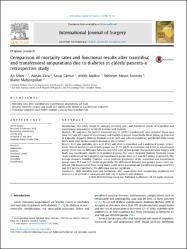| dc.contributor.author | Şeker, Ali | |
| dc.contributor.author | Kara, Adnan | |
| dc.contributor.author | Çamur, Savaş | |
| dc.contributor.author | Malkoç, Melih | |
| dc.contributor.author | Sönmez, Mehmet Mesut | |
| dc.contributor.author | Mahiroğulları, Mahir | |
| dc.date.accessioned | 10.07.201910:49:13 | |
| dc.date.accessioned | 2019-07-10T19:56:54Z | |
| dc.date.available | 10.07.201910:49:13 | |
| dc.date.available | 2019-07-10T19:56:54Z | |
| dc.date.issued | 2016 | en_US |
| dc.identifier.citation | Şeker, A., Kara, A., Çamur, S., Malkoç, M., Sönmez, M. M. ve Mahiroğulları, M. (2016). Comparison of mortality rates and functional results after transtibial and transfemoral amputations due to diabetes in elderly patients-a retrospective study. International Journal Of Surgery, 33. 78-82, (Part A). https://dx.doi.org/10.1016/j.ijsu.2016.07.063 | en_US |
| dc.identifier.issn | 1743-9191 | |
| dc.identifier.issn | 1743-9159 | |
| dc.identifier.uri | https://dx.doi.org/10.1016/j.ijsu.2016.07.063 | |
| dc.identifier.uri | https://hdl.handle.net/20.500.12511/2846 | |
| dc.description | WOS: 000386892400014 | en_US |
| dc.description | PubMed ID: 27475745 | en_US |
| dc.description.abstract | Introduction: This study aimed to compare mortality rates and functional results of transtibial and transfemoral amputations in elderly patients with diabetes. Methods: 87 amputees [54 (62.1%) transtibial and 33 (37.9%) transfemoral] were included. Mean ages were 70.7 and 69.3 years in transfemoral and transtibial groups, respectively. Mean follow up time was 41.8 months. Amputee Mobility Predictor scores (with and without prosthesis) and Barthel Daily Living Index were used for functional evaluation of the survivors. Results: First year mortality rates were 29.6% and 30.3% in transtibial and transfemoral groups, respectively. Overall mortality rate of both groups was 65.5% (66.7% in transtibial and 63.6% in transfemoral group). There was no difference between mortality rates of two groups. Duration between surgery and death was significantly shorter in transfemoral group. The mean Amputee Mobility Predictor scores (with prosthesis) of the transtibial and transfemoral groups were 32.3 and 26.9 points, respectively. The average Amputee Mobility Predictor scores (without prosthesis) of the transtibial and transfemoral groups were 29.5 and 22.7 points respectively. The differences between two groups' scores were significant. The mean Barthel Daily Living Index scores of the transtibial and transfemoral groups were 82.5 and 80.2 points respectively. The difference was not significant. Conclusions: High mortality rates and morbidities after major lower limb amputations emphasize the importance of preventive measures and foot care in patients with diabetes. | en_US |
| dc.language.iso | eng | en_US |
| dc.publisher | Elsevier Science Bv | en_US |
| dc.rights | info:eu-repo/semantics/openAccess | en_US |
| dc.subject | Diabetes | en_US |
| dc.subject | Functional Results | en_US |
| dc.subject | Mortality | en_US |
| dc.subject | Transtibial | en_US |
| dc.subject | Transfemoral | en_US |
| dc.title | Comparison of mortality rates and functional results after transtibial and transfemoral amputations due to diabetes in elderly patients-a retrospective study | en_US |
| dc.type | article | en_US |
| dc.relation.ispartof | International Journal Of Surgery | en_US |
| dc.department | İstanbul Medipol Üniversitesi, Tıp Fakültesi, Cerrahi Tıp Bilimleri Bölümü, Ortopedi ve Travmatoloji Ana Bilim Dalı | en_US |
| dc.authorid | 0000-0003-1259-6668 | en_US |
| dc.identifier.volume | 33 | en_US |
| dc.identifier.startpage | 78 | en_US |
| dc.identifier.endpage | 82 | en_US |
| dc.relation.publicationcategory | Makale - Uluslararası Hakemli Dergi - Kurum Öğretim Elemanı | en_US |
| dc.identifier.doi | 10.1016/j.ijsu.2016.07.063 | en_US |
| dc.identifier.wosquality | Q1 | en_US |
| dc.identifier.scopusquality | Q2 | en_US |


















